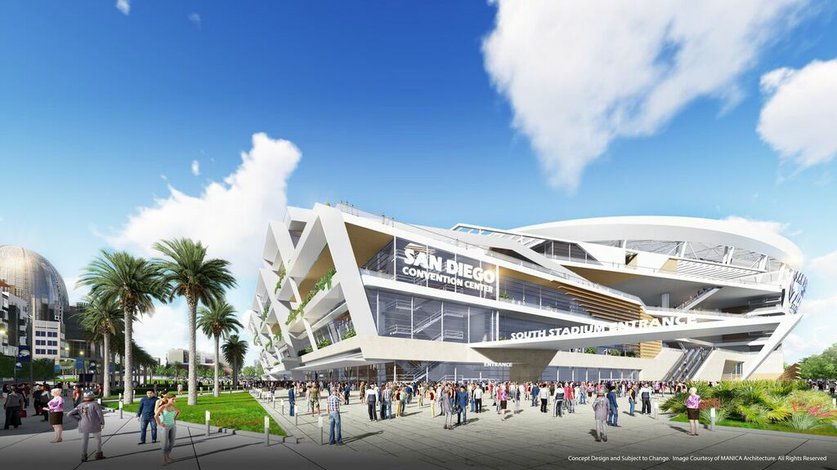We have another proposed San Diego Chargers stadium plan, this one coming from a former councilman and current talk-show host pitching a $1.5 billion facility that won’t involve any tax revenues.
Carl DeMaio is basing his plan on a combination of fan licenses, corporate investment and a $450-million Chargers/NFL payment. In addition, his plan would devote naming-rights money to the project and not to the team as a larger sponsorship deal. (Indeed, NFL naming-rights deal involve a lot more than just hanging a sign on the stadium exterior.)
It does have a few advantages for some San Diego business leaders. First, it doesn’t rely on a convention center to generate revenue and would allow hoteliers to push for their preferred contiguous convention-center expansion. Second, it wouldn’t touch hotel taxes, unlike the Chargers plan. From the San Diego Union-Tribune:
“None of these options have been discussed in the context of a ‘San Diego solution,’” DeMaio said in an interview Wednesday. “The Chargers have their solution and I don’t fault them for developing a position that is very favorable to their interests.”
The Chargers’ initiative relies on raising the current city hotel room tax from 12.5 percent to 16.5 percent, $650 million from the team and NFL and other sources that could underwrite a $1.8 billion, publicly owned facility with 65,000 seats for a stadium and an attached convention exhibit hall, meeting rooms and ballrooms that can expand to the stadium field.
But there are a few line items that may be more wishful thinking than anything based on a research-based conclusion. To wit (based on the San Diego Union-Tribune assessment of the funding plan):
- $300 million from “FanLord” shares, ranging from $5,000 for limited-access standing-room-only to $700,000 per suite. That’s a lot for what’s basically a hopped-up Personal Seat License. Selling $300 million in seat licenses is an awfully tall order: the Minnesota Vikings have sold almost $100 million in PSLs, at $9,500 a pop. Now, this may be apples to oranges, as the FanLord program also includes suites, which are usually separately sold. At U.S. Bank Stadium, again, the best suites will go for $20,000-$30,000 per NFL game and less than that for preseason games and other events. Budgeting $700,000 for a suite seems to be very ambitious, and experience shows us that selling a suite is a much different process than selling a PSL. Then again, the San Francisco 49ers sold $531.5 million in Stadium Builders Licenses for Levi’s Stadium. Is San Diego more like San Francisco/the Bay Area or Minneapolis? In terms of corporate support, probably Minneapolis, as studies have shown.
- $200 million from a boutique hotel development partner with $62.5 million for the hotel and the remainder set aside for the stadium. On its face, it doesn’t seem realistic to ask a hotel investment firm to pay $200 million for a $62.5-milion hotel.
- $300 million from a retail partner with $60 million for the retail portion and remainder for the stadium. Again, asking an investor to spend $300 million on something worth $60 million may be a reach.
It will also take some complicated maneuvering to make it on the fall ballot as well. Still, San Diego politics are anything but predictable, and surely a discussion will ensue from this proposal.
Renderings courtesy San Diego Chargers and Manica Architecture.
RELATED STORIES: Chargers: 110,000 Signatures Means November Vote on New Stadium; Chargers Push San Diego Downtown Stadium at Rally; Preliminary Chargers Stadium Design Renderings Released; City Attorney Criticizes Citizens’ Plan; Chargers Meeting With Citizens’ Plan Advocates; Convadium Facing Local Scrutiny; Chargers Begin Stadium Initiative; Chargers Pitch “Convadium”

